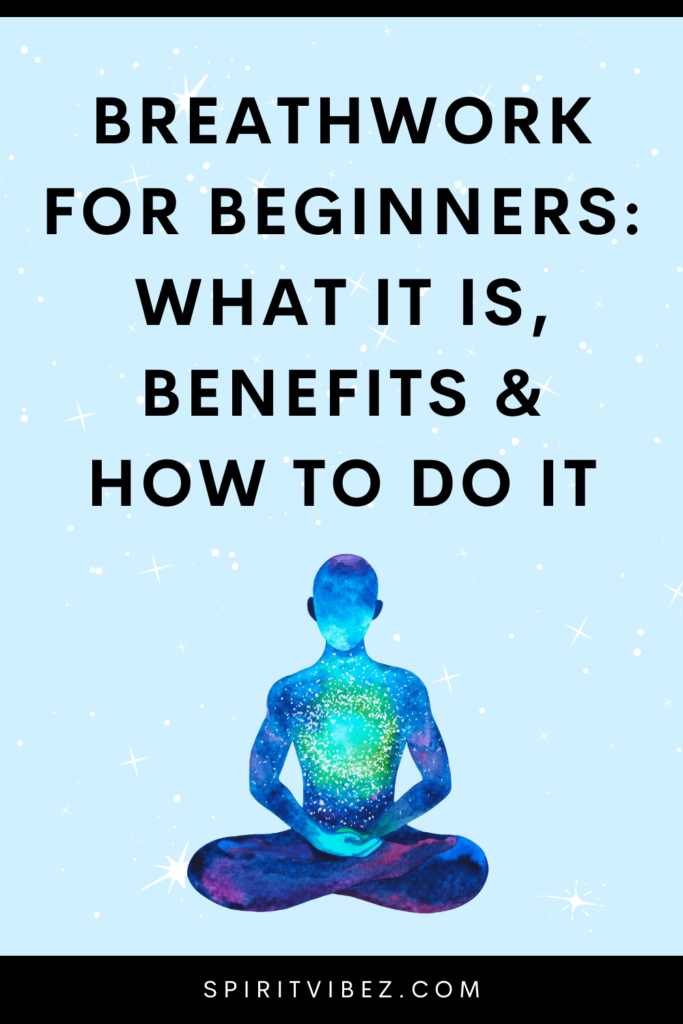Last Updated on February 6, 2025

Breathwork is an ancient practice that has gained widespread recognition for its ability to promote relaxation, healing, and spiritual awakening.
From reducing stress to enhancing manifestation, conscious breathing techniques can transform your mind, body, and soul.
In this article, we’ll explore breathwork for beginners, including the benefits, different techniques, and how to incorporate breathwork exercises into your daily life.
What is breathwork?
Breathwork refers to controlled breathing techniques that influence physical, mental, and emotional well-being.
It affects the autonomic nervous system, either activating the “fight or flight” response (sympathetic) or promoting relaxation (parasympathetic).
Breathwork techniques like Holotropic breathwork and the Wim Hof Method alter oxygen and carbon dioxide levels, leading to physiological and psychological effects such as stress reduction, enhanced focus, and emotional release.
Breathwork is used in yoga, meditation, and therapy, it can deepen self-awareness, heal trauma, and induce altered states of consciousness.
Breathwork benefits
Practicing breathwork exercises regularly can lead to profound physical, mental, and spiritual benefits, including:
- Stress and anxiety reduction: Deep breathing activates the parasympathetic nervous system, reducing cortisol levels and promoting relaxation. (Breathwork for anxiety is a proven method for calming the mind.)
- Improved mental clarity: Increased oxygen supply enhances cognitive function, focus, and mindfulness.
- Emotional release: Breathwork helps process and release suppressed emotions, leading to emotional balance.
- Enhanced manifestation: Conscious breathing raises vibrational frequency, aligning the mind with desired intentions.
- Detoxification & increased energy: Deep breathing removes toxins from the body and boosts vitality.
How to practice breathwork
Breathwork techniques range from simple calming exercises to more intense, transformative practices.
Here are some of the most popular types of breathwork and how to do them:
1. Diaphragmatic (belly) breathing
A simple breathwork exercise to enhance overall well-being.
Best for: Stress relief, relaxation, and better oxygenation.
How to do it:
- Sit or lie down comfortably.
- Place one hand on your chest and the other on your belly.
- Inhale deeply through your nose, allowing your belly to expand while keeping your chest still.
- Exhale slowly through your mouth.
- Repeat for 5–10 minutes.
2. Box breathing (Square breathing)
A powerful breathwork technique used by athletes and military personnel.
Best for: Calming the nervous system, focus, and stress relief.
How to do it:
- Inhale through your nose for 4 seconds.
- Hold your breath for 4 seconds.
- Exhale slowly through your mouth for 4 seconds.
- Hold again for 4 seconds.
- Repeat for a few minutes.
3. 4-7-8 breathing
One of the best breathwork exercises for calming the mind.
Best for: Anxiety, relaxation, and sleep.
How to do it:
- Inhale deeply through your nose for 4 seconds.
- Hold the breath for 7 seconds.
- Exhale slowly through your mouth for 8 seconds.
- Repeat for 4–8 rounds.
4. Alternate nostril breathing (Nadi shodhana)
A breathwork meditation technique for deep focus and balance.
Best for: Balancing energy, mental clarity, and relaxation.
How to do it:
- Use your thumb to close your right nostril.
- Inhale deeply through your left nostril.
- Close the left nostril with your ring finger, release the right nostril, and exhale.
- Inhale through your right nostril, then switch and exhale through the left.
- Repeat for 5 minutes.
5. Wim Hof method
A breathwork session known for boosting performance and cold resistance.
Best for: Increased energy, endurance, resilience, and immune support.
How to do it:
- Take 30–40 deep breaths in and out through your mouth (without forcing the exhale).
- After the last breath, exhale fully and hold your breath for as long as possible.
- Inhale deeply and hold for 15 seconds, then exhale.
- Repeat for 3 rounds.
⚠️ Caution: Avoid doing this while driving or in water, as it can cause dizziness or fainting.
6. Holotropic breathwork
One of the most intense types of breathwork, leading to deep emotional release.
Best for: Emotional release, trauma healing, and altered states of consciousness.
How to do it:
- Breathe rapidly and deeply in a circular pattern (no pauses between inhales and exhales).
- Continue for 30 minutes to 2 hours while lying down with eyes closed.
- Allow emotions, visions, or sensations to arise naturally.
⚠️ Caution: This is intense and best done with a trained facilitator.
7. Rebirthing breathwork
A breathwork session designed for deep subconscious healing.
Best for: Deep emotional healing and trauma release.
How to do it:
- Breathe in a continuous, connected rhythm (no pauses between inhales and exhales).
- Focus on full, relaxed breaths, allowing emotions to surface.
- Continue for 30 minutes to an hour.
⚠️ Caution: This can be an intense practice, best done with a guide.
See also: 5 best breathwork exercises to release trauma
How long to practice breathwork
The duration of breathwork depends on the technique and your goals:
- Short daily practice (1–5 minutes): Great for quick stress relief, focus, or grounding (e.g., box breathing, 4-7-8 breathing).
- Moderate sessions (10–20 minutes): Ideal for deeper relaxation, emotional balance, and nervous system regulation (e.g., diaphragmatic breathing, alternate nostril breathing).
- Long sessions (30–60+ minutes): Used for intense emotional release, deep meditation, or altered states of consciousness (e.g., Holotropic Breathwork, Rebirthing Breathwork).
Beginners should start with shorter sessions and gradually increase time as they become more comfortable. Always listen to your body and avoid overexertion.
Breathwork is a powerful tool that connects the mind, body, and spirit, offering profound benefits for overall well-being.
Whether you’re looking to reduce stress, improve focus, or deepen your spiritual practice, incorporating breathwork exercises into your daily life can lead to lasting transformation.
Start small, be consistent, and allow the breath to guide you toward healing and balance.
Have you tried breathwork? Share your experiences in the comments below!
If you enjoyed this article on breathwork for beginners, I would be grateful if you shared it on Twitter, Facebook, or Pinterest! Thank you❤️
📌 PIN THIS POST FOR LATER


Hello, my name is Sara and I am the founder of Spiritvibez, I’m here to guide you on your spiritual journey toward healing, growth, and self-discovery. I believe that true transformation occurs when the mind, body, and spirit are aligned and working in harmony. Through Spiritvibez, I hope to inspire and empower you to deepen your spiritual practice, embrace your authentic self, and begin living your best life.
